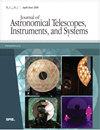∂Lux的可微光学:平面场的I-deep校准和自动微分的相位检索
IF 3.1
3区 工程技术
Q2 ENGINEERING, AEROSPACE
Journal of Astronomical Telescopes Instruments and Systems
Pub Date : 2023-04-01
DOI:10.1117/1.JATIS.9.2.028007
引用次数: 1
摘要
摘要空间望远镜的灵敏度限制受到点扩展函数、光子噪声、背景光和探测器灵敏度等方面的未校准误差的影响。这些通常是用专门的波前传感器硬件和在地面或校准源上获得的平场进行校准的,但是这些在检测器条件下留下了残留时变或非常见路径像差和变化的脆弱性。因此,面对相位检索和像素级校准的高维问题,仅从科学数据中推断这些是可取的。我们引入了一个新的用于物理光学模拟的Python包∂Lux,它使用机器学习框架Jax来实现图形处理单元加速和自动微分(autodiff),并将其应用于模拟天文成像。在这一系列论文的第一篇中,我们展示了由autodiff启用的梯度下降可以同时用于检测器灵敏度的相位检索和校准,有效地缩放到推断数百万个参数。这个新框架可以在天文学和其他领域的数据分析和硬件设计中实现高维优化和推理,我们将在本系列的后续论文中对此进行探讨。本文章由计算机程序翻译,如有差异,请以英文原文为准。
Differentiable optics with ∂Lux: I—deep calibration of flat field and phase retrieval with automatic differentiation
Abstract. The sensitivity limits of space telescopes are imposed by uncalibrated errors in the point spread function, photon-noise, background light, and detector sensitivity. These are typically calibrated with specialized wavefront sensor hardware and with flat fields obtained on the ground or with calibration sources, but these leave vulnerabilities to residual time-varying or non-common path aberrations and variations in the detector conditions. It is, therefore, desirable to infer these from science data alone, facing the prohibitively high dimensional problems of phase retrieval and pixel-level calibration. We introduce a new Python package for physical optics simulation, ∂ Lux, which uses the machine learning framework Jax to achieve graphics processing unit acceleration and automatic differentiation (autodiff), and apply this to simulating astronomical imaging. In this first of a series of papers, we show that gradient descent enabled by autodiff can be used to simultaneously perform phase retrieval and calibration of detector sensitivity, scaling efficiently to inferring millions of parameters. This new framework enables high dimensional optimization and inference in data analysis and hardware design in astronomy and beyond, which we explore in subsequent papers in this series.
求助全文
通过发布文献求助,成功后即可免费获取论文全文。
去求助
来源期刊

Journal of Astronomical Telescopes Instruments and Systems
Engineering-Mechanical Engineering
CiteScore
4.40
自引率
13.00%
发文量
119
期刊介绍:
The Journal of Astronomical Telescopes, Instruments, and Systems publishes peer-reviewed papers reporting on original research in the development, testing, and application of telescopes, instrumentation, techniques, and systems for ground- and space-based astronomy.
 求助内容:
求助内容: 应助结果提醒方式:
应助结果提醒方式:


